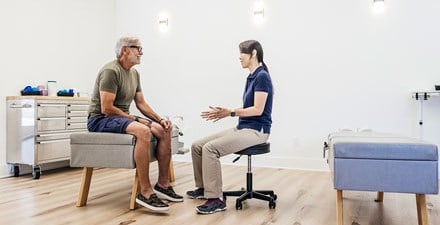
Pregnancy can be an exciting and joyous experience for many women. It also can come with discomfort, health concerns, and anxiety about the labor and birth process.
A physical therapist can help you understand the cause of your discomfort. They also can:
- Help you develop healthy movement habits during pregnancy.
- Educate you about available treatment options when pain arises.
- Prepare you for your upcoming birth.
Common Causes for Discomfort During Pregnancy
A woman's body undergoes incredible physical, mental, and emotional changes during pregnancy. A pregnant mother may encounter joint, bone, or muscle aches. The back, hip, and pelvic areas change to accommodate a growing baby. And the added weight of the baby can cause discomfort, especially in the later stages of pregnancy.
Here are a few areas that can contribute to pain:
- Changes in posture.
- Increased stress on the joints from extra weight (joint loading).
- Increased joint and muscle looseness (laxity).
- Decreased muscle strength.
Relief With a Physical Therapist Treatment Plan
Your physical therapist can tailor a treatment plan to your specific needs. They can explain the underlying issues and what you can do to find relief. Physical therapists also can teach pain management techniques and educate on proper movement during pregnancy.
A physical therapist can help you build the strength and endurance needed for pregnancy. Targeting critical areas such as the hips, back, and abdomen can lead to:
- Significant pain relief.
- Improvements in how your body converts food to energy (metabolic improvement).
- A boost in energy.
- Mental and physical preparation for birth.
- A speedier recovery after pregnancy.
Unless there is a medical reason, most women can and should maintain their physical activity level during pregnancy. Most new moms also can resume their regular physical activity after giving birth (postpartum) when cleared by their OB/GYN.
Regular physical activity during pregnancy helps you stay physically fit, manage blood pressure, and reduce the risk of:
- Excessive weight gain.
- Incontinence.
- Gestational diabetes.
- Back and pelvic pain.
Physical therapists can develop or adjust a personalized treatment program during pregnancy and after birth. This treatment plan can help reduce pain. It also can help relieve muscle, bone, and joint problems if experienced.
Physical therapist treatment may include:
- Exercises. Exercises focusing on the heart (cardiovascular) and muscular systems can benefit you during pregnancy. Swimming is especially excellent. It offers aerobic benefits, and the water helps support the baby, taking the pressure off your back and joints. Similarly, Kegel exercises can help you build the pelvic muscles essential to pregnancy, labor, and delivery. Walking or running are also beneficial. Be sure to consult with your physical therapist before starting a program to learn the best exercises for you.
- Stretches. Regular stretching can help you build strength in your joints and muscles. There are many yoga poses that you can practice to reduce pain and build strength and endurance. Yoga stretches also can help you relax to prepare for labor and birth.
Physical therapists are movement experts. They improve quality of life through hands-on care, patient education, and prescribed movement. You can contact a physical therapist directly for an evaluation. To find a physical therapist in your area, visit Find a PT.


